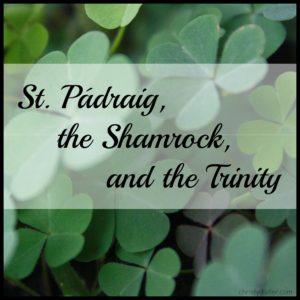 Lá Fhéile Pádraig Sona Daoibh!
Lá Fhéile Pádraig Sona Daoibh!
That’s Happy St. Pádraig’s Day, in Irish. But just who was St. Pádraig really? (Hint: He’s not the patron saint of inebriation, as my friend’s Irish mother used to say in disgust at what his holiday had become in the U.S.) Truly, Pádraig deserves a bit more honor, so let’s set the record straight.
Pádraig (the Irish spelling) was born in what’s now Dumbarton, Scotland (northwest of Glasgow) in the 5th century A.D.. He was kidnapped by Irish pirates around the age of sixteen and taken to Ireland as a slave. Even though he escaped back to his family about six years later, he returned to Ireland after becoming a cleric and served the people of the northern and western parts of the country as a Christian missionary.
In his mission work, he used the shamrock to teach Irish chieftains, high kings, lords, and druids about the Trinity. (Having spent years in Ireland, he understood the Irish clan system and set out to convert the upper classes, which would then convert their clans.) He would hold up the shamrock and ask them if it was one leaf or three leaves. His listeners would answer that it was both one leaf and three leaves. “And so it is with God,” he told them. “He is one God in three persons: the Father, the Son, and the Holy Spirit.”
It’s been said that Pádraig brought Christianity to Ireland. This isn’t completely true, since there were already many Christian slaves in Ireland at the time, but Pádraig was very influential in converting many of the Irish upper class, as well as others, to Christianity. He is now one of the three patron saints of Ireland.
“Go therefore and make disciples of all nations, baptizing them in the name of the Father and of the Son and of the Holy Spirit, teaching them to observe all that I have commanded you. And behold, I am with you always, to the end of the age.”
—Matthew 28:19–20 ESV
Lá Fhéile Pádraig Sona Daoibh!

Recent Comments